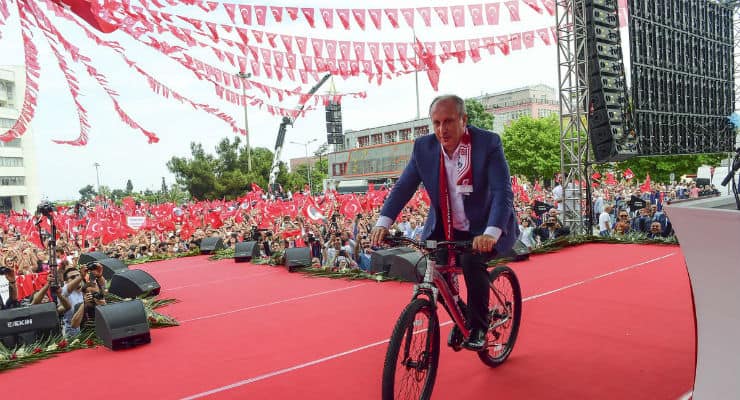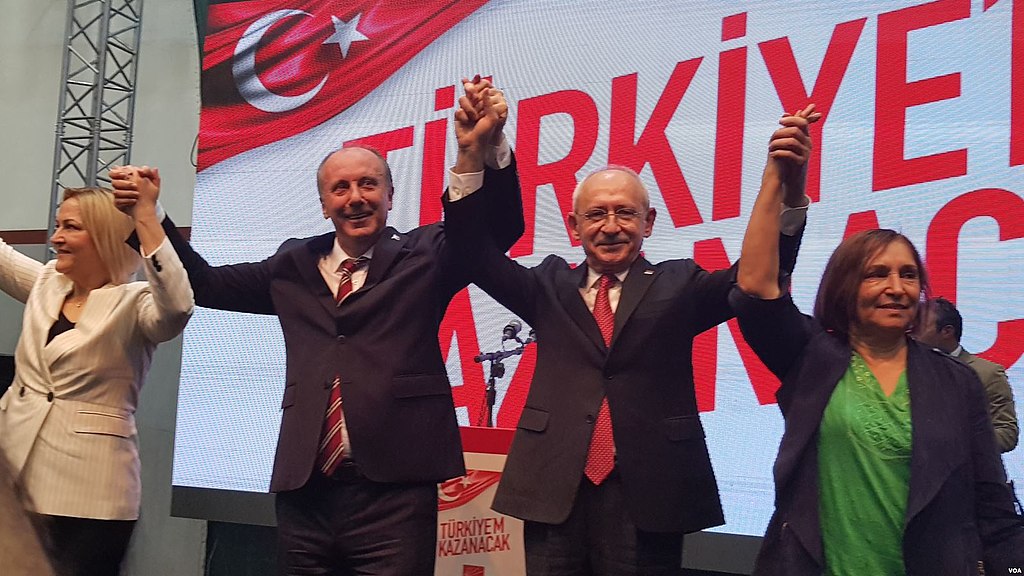Snap presidential elections will take place in Turkey on 24 June 2018. Although the plan of the Turkish President, Recep Tayyip Erdoğan, was to crush his opponents in a blitz campaign, it seems that the authoritarian Turkish leader failed to foresee the rise in popularity of his left populist opponent Muharrem İnce. According to the polls, only 1% would separate Erdogan from İnce in the second round of the elections. Today, The New Pretender presents an analysis of Muharrem İnce’s populist strategy.
It was originally published on the Turkish website diken.com and translated from the Turkish by Ata Mert Binicioğulları and Eylem Taylan.
This article is cross-posted from our partner website The New Pretender

The short period of time that separated the announcement of the snap election and the unfolding of the electoral campaign caused many details to go unnoticed by both Turkish citizens and international observers. Keeping track of a hectic campaign, which may include three to four rallies a day in different cities, is not an easy task —never mind when confusion is strengthened by media censorship against opposition candidates.
After the CHP [The Kemalist Republican People’s Party] announced Muharrem Ince’s presidential candidacy, Ince launched a series of rallies across the country. With HDP candidate Selahattin Demirtaş under arrest [the left-wing leader of the HDP was arrested in November 2016] , Ince was the only left-of-center candidate able to hold such gatherings to challenge Erdogan’s power. Interestingly, Ince’s rallies contrasted in many ingenuous ways with the traditional campaigning style of the CHP —as incarnated by the Kemalist candidate Chairperson Kılıçdaroğlu in 2011 and 2015. The development of CHP’s campaign represents a new and interesting evolution.

Compared to the Kemalist electoral campaigns of the past, Ince has inaugurated a new strategy based on a ‘thin’ (Muharrem İnce’s surname means “thin” in Turkish) and ambiguous line —that of ‘left populism’. I thought it might be helpful —especially for our international friends — to draw a list of the populist elements that appear in Muharrem Ince’s rallies.
1) Like many other books and articles on populism, it is worth stating that populism does not have “a fixed definition”. Populism, which is practiced and disseminated through ’empty signifiers’ (i.e. vague appealing concepts that mean something different for everyone —such as ‘democracy’ or ‘peace’) is a phenomenon that cannot be easily defined; but can be felt or understood as one encounters it.
2) As a point of entry to Muharrem İnce’s association with left-populism, his “Yes, I am poor” outburst seems like a good place to start. İnce succeeded in reversing the classist sneer of Erdoğan, who had mocked his opponent by declaring: “I feel pity for that poor guy”. İnce’s pithy answer (“Yes I am poor, I am poor Muharrem”) not only displayed his skills at witty comebacks, but it also emphasized a sine qua non grounding of every type of populism —the opposition between the people and the elite. In a similar vein, İnce also attacked Erdoğan for building himself a palace after having spent years deriding the secular bureaucratic elite. Ince did not hesitate to compare Erdoğan’s lifestyle with his own, insisting that “I was a tenant for 14 years and although I bought a house 2 years ago, I have not had enough time to properly enjoy it.” In the event he should win the elections, Ince explained that he would keep his own house instead of moving to “AK Palace” [a popular pun to designate Erdoğan’s palace, after the name of his party, AKP].
3) The specificity of Ince’s discourse also contrasts with traditional left-wing parties. Whereas it could be argued that other left-wing parties, such as Demirtaş and HDP, offer a more universal left-wing politics, İnce makes more ‘particular’ points in his speeches. Where Demirtaş and HDP focus only on universal ideas such as equality and minority rights, Ince indulges in emphasizing ‘the national’ and ‘the patriotic’ by encouraging the increase of national production and the industrialization of the country.
4) The dictionary meaning of a word is important insofar as it reveals the place of that word according to the general ‘common sense’. Definition for the word “demagogue” (demagog in Turskish) is brushed off by the dictionary of Turkish Linguistic Society with the short caption: ‘silver-tonguedness’’ (the closest definition that I could find for the rather derogatory Turkish idiom “laf cambazlığı”). However, if you search for the meaning of the word in English, you will find this definition: “a political leader who seeks support by appealing to popular desires and prejudices rather than by using rational argument.” The second result of the very same Google search is also illuminating: “(in ancient Greece and Rome) a leader or orator who espoused the cause of the common people”
5) If we consider İnce’s statements from his 19-20 May rallies in light of the simple framework that I laid out above, we can group them in 2 sets. On the one hand Ince appeals to popular desires by calling for more democracy and social harmony. On the other, he clearly uses popular prejudices (especially in the areas of the country that are the most affected by the Syrian refugee wave) by laying stress on the fact that Erdoğan ‘could have developed the infrastructure and economy of the country instead of spending 40 billion dollars for Syrians’.
6) It also appears that İnce does not shy away from the ‘performative’ qualities expected from a populist leader. Indeed, several symbolical gestures enabled Ince’s increase in charisma. His ending every speech with ‘Put on the İzmir Marşı (a popular Kemalist march)’, his leaving the stage on a bicycle during a rally at Sinop, and his assistance of a farmer to bale some hay in the midst of his campaign trail are but a few instances of Ince’s ability to perform his image as ‘champion of the people’. Similar images of Hugo Chavez, who could be acclaimed as the most successful practitioner of left-wing populism, can easily be found online.

As another example of Ince’s witticism, I would like to evoke the end of a rally when the soundtrack of “İzmir Marşı” would not play. Feeling the awkwardness of the moment, Ince suddenly called out his sounds mixer, asking “Hasan brother, how are you?”. This in reference to a well-known Turkish football commentator of the 2000s who famously called out his sound director on live TV provoked the hilarity of the public and amplified Ince’s fame as a masterful orator.
7) In his book What is populism? Jan-Werner Müller explains that one of the common characteristics of left and right populist leaders is to address the “people” outwith mediating institutions —thus undermining the legitimacy of those institutions. On the contrary, İnce emphasizes the “rule of law” and the “separation of powers” whilst asserting that he would be a “ non-partisan president”. Such pledges contrast with İnce’s populist rhetoric and might create interesting tensions in case he should be elected.
8) Last of all; it is uncertain how successful İnce could be against his ‘mirror image’, President Erdoğan, during the second round of the elections. What is already clear, however, is that Erdoğan must now confront a new and different kind of political opposition. For the first time, it appears that the Turkish President might lose his monopoly over the dichotomy ‘people/nation vs. elites’ which he masterfully employed for the last sixteen years.


Be the first to comment